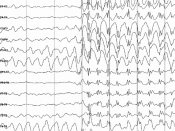Epilepsy Research Paper
The word "epilepsy" is derived from the Greek word meaning a condition of being overcome, seized or attacked. (2) Epilepsy is not a disease. It is a symptom of a neurological disorder--a physical condition--that from time to time, produces brief disturbances in the normal electrical functions of the brain. Epilepsy is characterized by sudden, brief seizures, which vary in nature and intensity from person to person. (3)
But what most people do not know is that there are many different types of seizures. Many people think of the most noticeable type--the generalized tonic-clonic seizure. Tonic-clonic seizures, which used to be referred to as "grand mal", are a generalized convulsion occurring in two phases. In the tonic phase, the person loses consciousness and falls, as the body stiffens. In the clonic phase, body extremities jerk and twitch. After the seizure, consciousness returns slowly. (2)
There are four other types of seizures.
These are called: infantile spasms, complex-partial seizures, atonic, and absence. (4) Infantile spasms are a special form of epilepsy, which occurs during infancy. The spasms usually begin when the baby is between three and eight months of age. In approximately 50 % of cases, the cause of infantile spasms is not known. However, in the other 50 % there are many different conditions affecting the brain, (such as birth malformation, injury and meningitis), which can cause this type of epilepsy. (2)
Complex-partial seizures are characterized by complicated motor action involving loss of awareness. The person appears dazed and confused--random walking, mumbling, head turning, or pulling at clothing may be observed. The person cannot recall these automatisms and spasms. In children, this seizure is easily confused with the absence seizure described below. (2)
Another type, absence seizures, which were formerly called "petit mal" are characterized by a...


